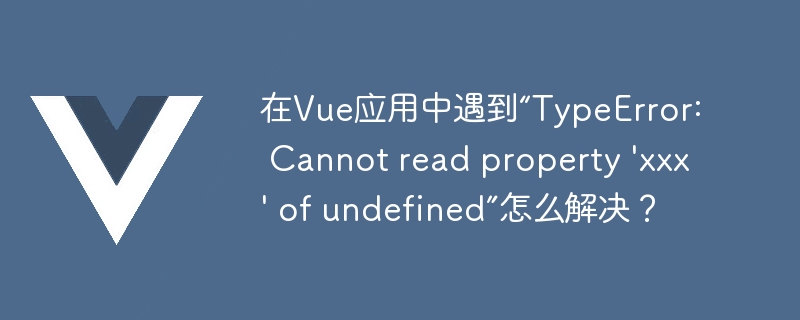Home >Web Front-end >Vue.js >How to solve 'TypeError: Cannot read property 'xxx' of undefined' in Vue application?
How to solve 'TypeError: Cannot read property 'xxx' of undefined' in Vue application?
- WBOYWBOYWBOYWBOYWBOYWBOYWBOYWBOYWBOYWBOYWBOYWBOYWBOriginal
- 2023-08-18 16:43:433991browse

How to solve "TypeError: Cannot read property 'xxx' of undefined" in Vue application?
In the process of developing Vue applications, we often encounter such an error message: TypeError: Cannot read property 'xxx' of undefined. This error message is usually caused by the object not being properly initialized or not assigned a value when reading the properties of an object. So, how to avoid this error from happening? Here are some solutions for you.
- Object Check
Before reading the properties of an object, first check the object to determine whether the object has been correctly initialized or assigned a value. For example, when accessing data in the store in a component, you can use $store.state.xxx for access. However, when the component is initialized, the store may not have been initialized yet, resulting in $store not being assigned a value, and the error message "TypeError: Cannot read property 'xxx' of undefined" will appear. Therefore, it is necessary to determine whether $store has been assigned before reading $store.state.xxx. As shown below:
if(this.$store) {
console.log(this.$store.state.xxx);
}- Data initialization
In a Vue application, you can use the data attribute to initialize the data of the component to ensure that the object does not appear when reading. undefined situation. For example, define a data attribute in the component as follows:
data() {
return {
xxx: ''
}
}An object xxx is defined here and initialized to an empty string. In this way, when accessing the xxx property in the component, the error message "TypeError: Cannot read property 'xxx' of undefined" will not appear.
- Use the v-if directive
In a Vue application, you can use the v-if directive to control the display or hiding of components. If a component has not been properly initialized or has not been assigned a value, you can use the v-if directive to determine whether the component needs to be displayed. For example, when accessing data in a store in a component, you can use the v-if directive to determine whether $store has been assigned a value, as shown below:
<template v-if="$store">
<div>{{ $store.state.xxx }}</div>
</template>The v-if directive is used here to determine whether $store has been assigned a value. is assigned a value. This component will only be displayed when $store has been assigned a value, thus ensuring that the "TypeError: Cannot read property 'xxx' of undefined" error message will not appear when reading $store.state.xxx.
- Use try-catch statement block
If none of the above methods can solve the problem, you can try to use try-catch statement block to catch the error. For example, when accessing data in the store in a component, you can perform access to $store.state.xxx in the try statement block. If an error occurs, handle the exception in the catch statement block, as follows:
try {
console.log(this.$store.state.xxx);
} catch (e) {
console.log(e);
} Here, access to $store.state.xxx is performed in the try statement block. If an error occurs, the exception is handled in the catch statement block. Although this method cannot solve the problem, it can help us quickly locate the error and solve the problem faster.
In short, when you encounter an error message such as "TypeError: Cannot read property 'xxx' of undefined" in a Vue application, you need to check the object first to ensure that the object has been correctly initialized or assigned a value. . If you still can't solve the problem, you can try to use v-if instructions, data initialization or try-catch statement blocks to solve the problem.
The above is the detailed content of How to solve 'TypeError: Cannot read property 'xxx' of undefined' in Vue application?. For more information, please follow other related articles on the PHP Chinese website!

